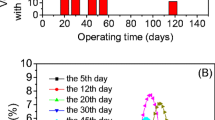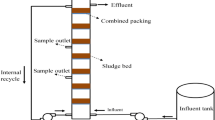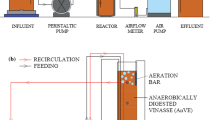Abstract
In this paper, the differences between reinforced sequencing batch reactor, which was inoculated with superior mixed flora, and conventional sequencing batch reactor were compared in the process of treating papermaking wastewater under similar conditions. The results showed that the addition of superior mixed flora could not only shorten the sludge acclimation time, but also improve the treatment efficiency of reactor as well as make the reactor have higher ability to withstand high volume loading rate; the phenomenon of aerobic granulation only occurred in reinforced sequencing batch reactor, and superior mixed flora were the key reason that aerobic granular sludge could shape; aerobic granular sludge had many advantages over conventional activated sludge such as it possessed compacter microbial structure, better settling performance, and lower water content.





Similar content being viewed by others
References
Rittman BE, Whiteman R (1994) Bioaugmentation: a coming of age. Wat Qua Int 1:12
Quan XC, Shi HC, Wang JL, Qian Y (2003) Biodegradation of 2,4-dichlorophenol in sequencing batch reactors augmented with immobilized mixed culture. Chemosphere 50(8):1069–1074
Yu ZT, William WM (2001) Bioaugmentation with resin-acid-degrading bacteria enhances resin acid removal in sequencing batch reactors treating pulp mill effluents. Wat Res 35(4):883–890
Morgenroth E, Sherden T, van Loosdrecht M, Heijnen JJ, Wilderer PA (1997) Aerobic granule in a sequencing batch reactor. Wat Res 31(12):3191–3194
Liu Y,Yang SF, Xu H, Woon KH, Lin YM, Tay JH (2003) Biosorption kinetics of cadmium(II) on aerobic granular sludge. Process Biochem 38:997–1001
Pan S, Tay JH, He YX, Tay STL (2004) The effect of hydraulic retention time on the stability of aerobically grown microbial granules. Lett Appl Microbiol 38:158–163
Schwarzenbeck N, Borges JM, Wilderer PA (2005) Treatment of dairy effluents in an aerobic granule sequencing batch reactor. Appl Microbiol Biotechnol 66:711–718
Arrojo B, Mosquera-Corral A, Garrido JM, Méndez R (2004) Aerobic granulation with industrial wastewater in sequencing batch reactors. Wat Res 38:3389–3399
Qin L, Liu Y, Tay JH (2004) Effect of settling time on aerobic granulation in sequencing batch reactor. Biochem Eng J 21:47–52
Beun JJ, van Loosdrecht MCM, Heijnen JJ (2002) Aerobic granulation in a sequencing batch airlift reactor. Wat Res 36(3):702–712
Beun JJ, Hendriks A, van Loosdrecht MCM, Morgenroth E, Wilderer PA, Heijnen JJ (1999) Aerobic granulation in a sequencing batch reactor. Wat Res 33:2283–2290
Tay JH, Liu QS, Liu Y (2002) Aerobic granulation in sequential sludge blanket reactor. Wat Sci Tech 46(4–5):13–18
Liu Y, Yang SF, Tay JH (2004) Improved stability of aerobic granules by selecting slow-growing nitrifying bacteria. J Biotech 108:161–169
Kapat A, Dey S (2000) An alternative approach to the detection of lignin: a note on the application of ELISA using polyclonal antibodies. Bioprocess Biosyst Eng 22(1):75–77
Akhila R, Resmi C, Senan C, Pavithran T, Emilia A (2005) Biosoftening of coir fiber using selected microorganisms. Bioprocess Biosyst Eng 28(3):165–173
Choudhury S, Sahoo N, Manthan M, Rohela RS (1998) Fungal treatment of pulp and paper mill effluents for pollution control. J Ind Pollut Control 14(1):1–13
Buzzini AP, Pires EC (2002) Cellulose pulp mill effluent treatment in an upflow anaerobic sludge blanket reactor. Process Biochem 38:707–713
Franta JR, Wilderer PA (1997) Biological treatment of papermill wastewater by sequencing batch reactor technology to reduce residual organics. Wat Sci Technol 35(1):129–136
Wang HL, Li ZY, Guo WY, Wang ZY, Pan F (2005) Study on the Cooperation between ligninolytic enzymes produced by superior mixed flora. J Environ Sci 17(4):620–622
Wang HL, Yu GL, Liu GS, Pan F (2006) A new way to cultivate aerobic granules in the process of papermaking wastewater treatment. Biochem Eng J 28:99–103
Azwar MA, Hussain KB, Ramachandran (2006) The study of neural network-based controller for controlling dissolved oxygen concentration in a sequencing batch reactor. Bioprocess Biosyst Eng 28 (4):251–265
APHA (1998) Standard methods for the examination of water and wastewater, nineteenth edn. American Public Health Association, Washington DC
Ghangrekar MM, Asolekar SR, Ranganathan KR (1996) Experience with UASB reactor start up under different operating condition. Wat Sci Tech 34:421–428
Moy BYP, Tay JH, Toh SK (2002) High organic loading influences the physical characteristics of aerobic sludge granules. Lett Appl Microbiol 34:407–412
Wang Q, Du GC, Chen J (2004) Aerobic granule cultivated under the selective pressure as a driving force, Process Biochem 39:557–563
Qin L, Tay JH, Liu Y (2004) Selection pressure is a driving force of aerobic granulation in sequencing batch reactors. Process Biochem 39:579–584
Peng DC, Bernet N, Delgenes JP, Moletta R (1999) Aerobic granular sludge—a case report. Water Res 33:890–893
Hu LL, Wang JL, Wen XH, Qian Y (2005) The formation and characteristics of aerobic granules in sequencing batch reactor (SBR) by seeding anaerobic granules. Process Biochem 40:5–11
Acknowledgments
This work was financed by the foundation of Henan normal university, China (No.052076) and the program for young scholars of high school of Henan Province (2005).
Author information
Authors and Affiliations
Corresponding author
Rights and permissions
About this article
Cite this article
Hailei, W., Guosheng, L., Ping, L. et al. The effect of bioaugmentation on the performance of sequencing batch reactor and sludge characteristics in the treatment process of papermaking wastewater. Bioprocess Biosyst Eng 29, 283–289 (2006). https://doi.org/10.1007/s00449-006-0077-9
Received:
Accepted:
Published:
Issue Date:
DOI: https://doi.org/10.1007/s00449-006-0077-9




